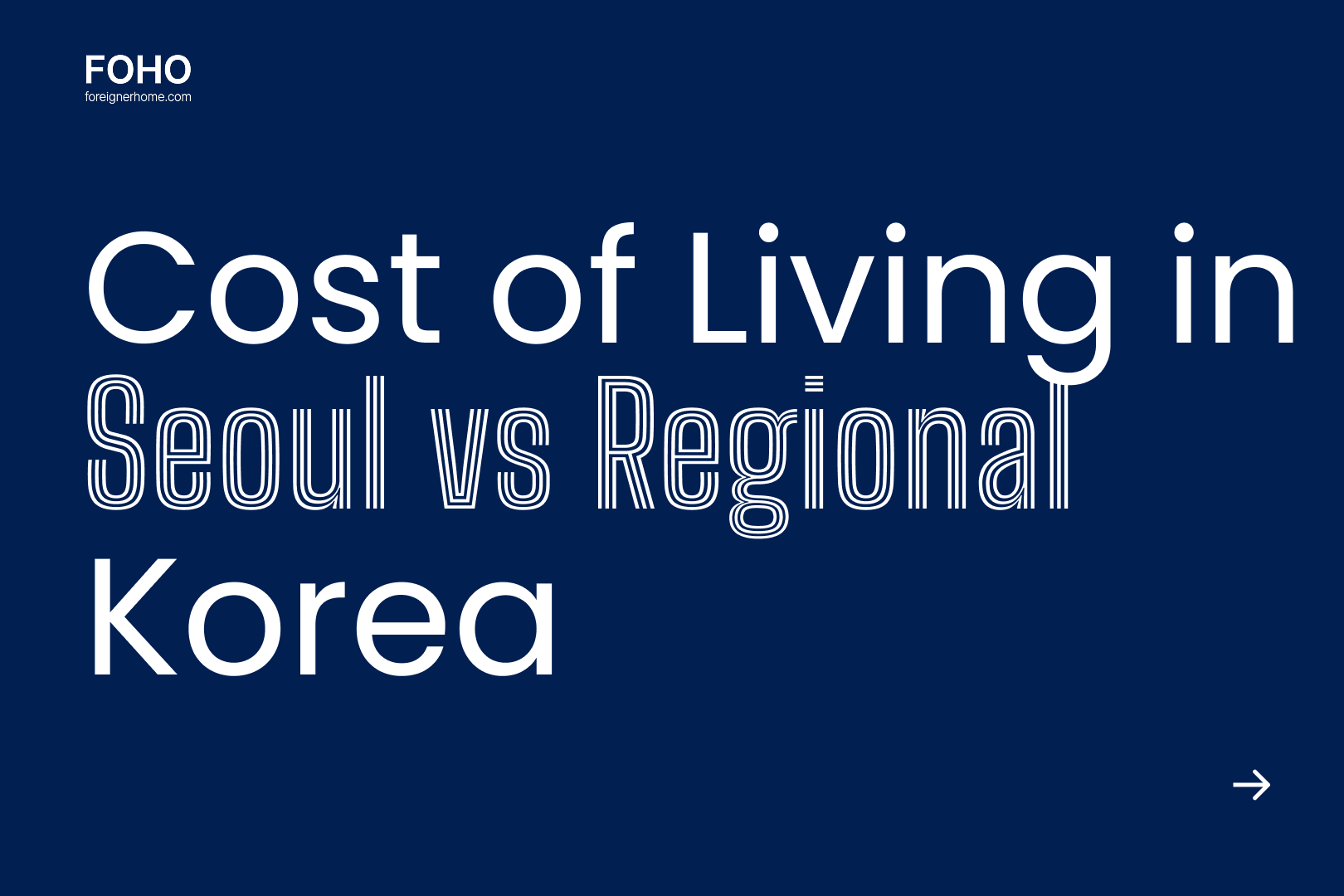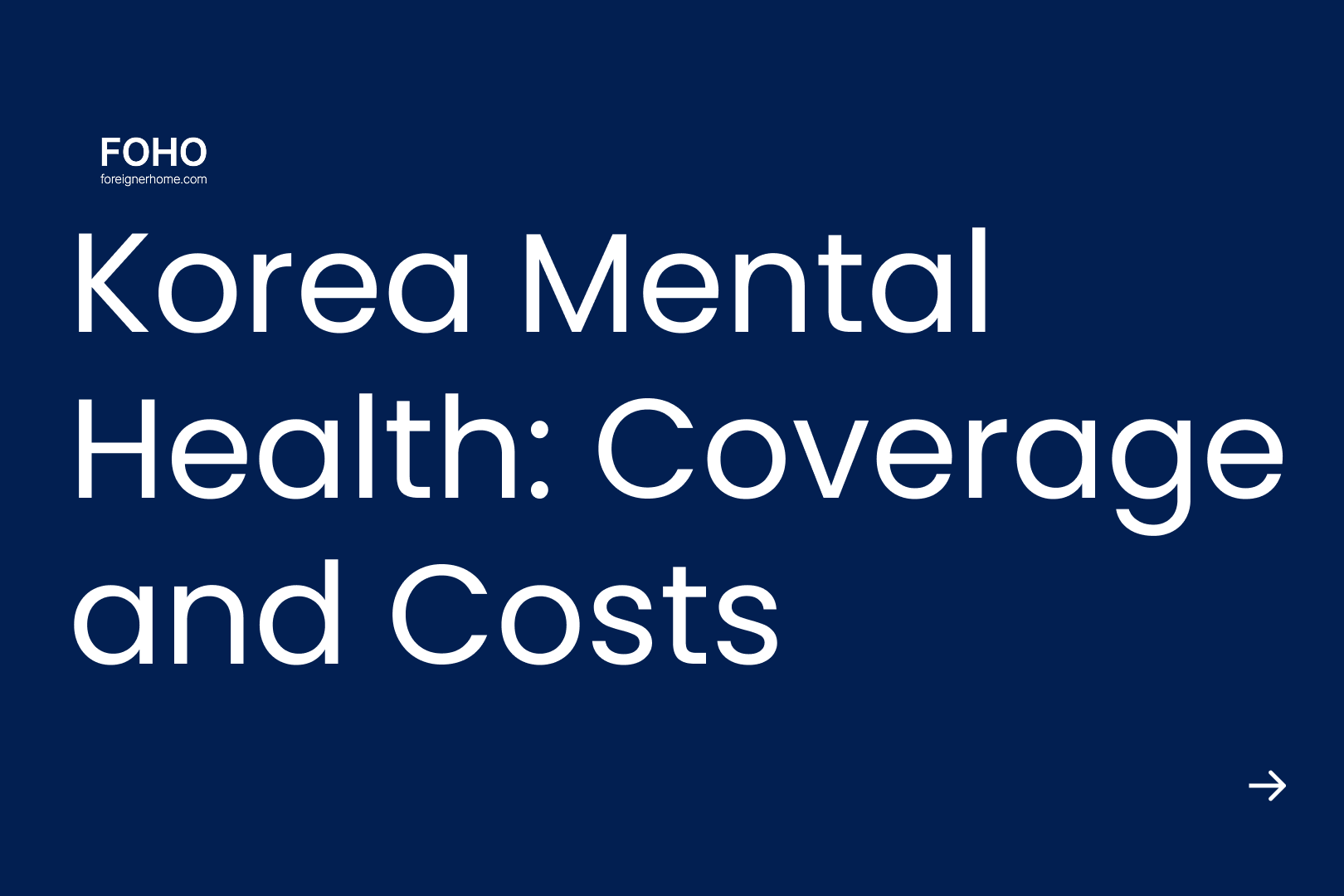FOHO Blog – Global Housing & Living Guide for Foreigners
Cost of Living in Seoul vs. Regional Korea (2025): A Complete Guide for Students & Working Holiday Makers
Compare the real cost of living in Seoul, Busan, Daegu, Gwangju, and Incheon. From rent to transport, discover where students and working holiday makers save most in Korea.

Table of contents
- 01Seoul vs. Regional Korea: A No-Nonsense Cost-of-Living Guide for Working-Holiday Makers & Students
- •At a glance: what actually drives the gap?
- •Monthly budget ranges (single person)
- •What this means for you (profiles & picks)
- •“Don’t get burned” housing facts (foreigners ask these most)
- •The trade-offs (so you won’t be surprised later)
- •City chooser: quick decision grid
- •A realistic starter budget (copy/paste & adjust)
- •Field-tested tactics (that actually move the needle)
- •Source notes & why they matter
- •Copy-ready checklist before you sign anything
- •Renting in Korea doesn’t have to be hard
Seoul vs. Regional Korea: A No-Nonsense Cost-of-Living Guide for Working-Holiday Makers & Students
The right city choice in Korea isn’t just about scenery. It decides how much you actually get to keep each month.
How to read this: Numbers below reflect modest single-person budgets (not extreme frugality, not luxury). Your actual spend varies with housing type, distance to work/school, and how often you eat out.
At a glance: what actually drives the gap?
- Rent dominates the difference. Seoul one-room averages recently hovered around the high-₩600k to ₩700k range, with popular districts much higher. (다음)
- Transport is cheap everywhere—and cheaper still in Seoul if you use the official Climate Card (unlimited 30-day pass from ₩62k–₩65k). (Official Website of the)
- Food & daily items vary less than rent across cities; what matters more is habit (home-cooking vs. eating out). National household-spend patterns are tracked by Statistics Korea; use them as a sanity check for your basket. (통계청)
Monthly budget ranges (single person)
Assumptions: One-room or small studio, standard refundable deposit; mixed home-cooking & casual dining; public transit user; basic phone plan; utilities included where noted.
City / Area | Rent (₩/mo) | Food (₩/mo) | Transport (₩/mo) | Utilities/Phone (₩/mo) | Estimated Total (₩/mo) | Notes |
Seoul (city) | 650k–900k+ | 300k–380k | 62k–65k (Climate Card) | 100k–150k | ~1.1M–1.5M | One-room averages near ₩700k; hot districts run 800–950k+. (다음) |
Incheon / Gyeonggi (Seoul suburbs) | 450k–650k | 300k–350k | 70k–90k (Seoul commute) | 90k–130k | ~0.95M–1.2M | Lower rent vs. Seoul; mind commute time/cost. (Official Website of the) |
Busan | 350k–550k | 280k–330k | 45k–60k | 80k–120k | ~0.8M–1.0M | Market listings frequently show studios mid-₩300k–₩500k. (rentola.kr) |
Daegu | 300k–500k | 260k–310k | 40k–55k | 80k–110k | ~0.8M–0.95M | Lower rents; compact city keeps transport low. (Benchmark via national spend & regional listings.) (통계청) |
Gwangju | 280k–450k | 240k–300k | 35k–50k | 80k–110k | ~0.75M–0.9M | Consistently among the more affordable large cities. (Benchmark via national spend & regional listings.) (통계청) |
Transit reality check: If you’re in Seoul and ride daily, the Climate Card usually beats pay-per-ride (adult fares often ₩1,200–₩1,500 each). (Official Website of the)
What this means for you (profiles & picks)
“Don’t get burned” housing facts (foreigners ask these most)
“Is the deposit (보증금) extra money I lose?”No. It’s refundable at move-out if there’s no damage/unpaid bills. Many landlords lower monthly rent when you accept a higher deposit. (Always put the contract under your name and keep copies of receipts.)
“What’s a realistic Seoul one-room number right now?”News analyses based on real transaction platforms put Seoul one-room averages ~₩700k recently, with Gangnam/Yongsan/Mapo higher. Expect ₩800k–₩900k for new, subway-close studios in hot areas. (다음)
“Busan looks cheaper—how cheap is actually realistic?”Market snapshots frequently show ₩350k–₩550k for basic studios (district and building age matter). Tourism-adjacent or beach-adjacent stock skews higher; older walk-ups inland skew lower. (rentola.kr)
The trade-offs (so you won’t be surprised later)
- Jobs & language: Seoul metro has more English-friendly roles and side gigs, but competition is fierce. Regional cities offer fewer openings; the flipside is calmer schedules and lower burn rate.
- Student life: Outside Seoul, campuses commonly bundle cheap dorms and meals. In Seoul, dorm demand is high; if you miss the lottery window, you may default to pricier studios around campus. (Cross-check your university’s current dorm rates and application schedule.)
- Transit vs. time: Seoul’s network is superb; buy the Climate Card and pick a place with a single-line commute. In smaller cities, you’ll likely ride buses or walk—cheap, but plan around route frequency. (Official Website of the)
- Groceries & eating out: Price levels converge across regions; your routine (home-cooking vs. cafés & convenience stores) drives variance more than the map does. Keep your own basket and compare against Statistics Korea consumption tables a few weeks in. (통계청)
City chooser: quick decision grid
If you value… | Pick… | Why |
Maximizing savings on a fixed contract | Gwangju / Daegu | Lowest typical rents for functional studios; short commutes keep incidental costs low. |
Big-city amenities without Seoul prices | Busan | Large job & social scene; studios commonly ₩350k–₩550k. (rentola.kr) |
Job density & side gigs | Seoul / Incheon / Gyeonggi | Highest opportunity density; offset costs with ₩62k–₩65k unlimited transit and strict rent caps. (Official Website of the) |
Simple transit budgeting | Seoul | Climate Card = fixed monthly cost; easy to forecast. (Official Website of the) |
A realistic starter budget (copy/paste & adjust)
Working-holiday in Seoul, modest lifestyle
- Rent: ₩750k (older studio, 10–12 min to subway)
- Food: ₩330k (home-cook 60%, casual dine 40%)
- Transport: ₩65k (Climate Card) (Official Website of the)
- Utilities/phone: ₩120k
Student in Daegu, dorm + bus
- Dorm/shared: ₩320k
- Food: ₩280k (cafeteria + groceries)
- Transport: ₩45k
- Utilities/phone: ₩90k
Field-tested tactics (that actually move the needle)
- Choose commute over “cheap rent far away.” A ₩80k rent saving evaporates if it adds an hour and transfers daily. (Time is money; burnout is real.)
- Leverage the deposit. If you can afford a higher deposit, negotiate for a lower monthly rent; on 12-month stays this often saves more than the opportunity cost of cash parked.
- Lock your transit cost. In Seoul, buy the Climate Card immediately; it caps your mobility spend at ₩62k–₩65k. (Official Website of the)
- Start with furnished & flexible. In regional cities, furnished studios at ₩350k–₩500k are common—good for testing neighborhoods without buying appliances. (rentola.kr)
- Benchmark your basket. After 30 days, compare your spend against Statistics Korea categories to see where you’re bleeding (cafés? delivery?). Adjust one habit at a time. (통계청)
Source notes & why they matter
- Transit prices: We rely on the official Seoul pages for the Climate Card (₩62k–₩65k / 30 days), ensuring your transport budget is anchored to non-negotiable facts. (Official Website of the)
- Seoul rent baselines: City-wide one-room averages near ₩700k come from Korean press coverage aggregating real transaction data, useful as a sanity check when a listing seems “too cheap to be true.” (다음)
- Regional rent texture: Busan examples are triangulated from active marketplaces (range ₩350k–₩550k for simple studios), giving live-market realism. Always read deposit & management-fee fine print. (rentola.kr)
- Spending patterns: Statistics Korea’s Household Income & Expenditure releases let you align your personal budget with national categories—useful for diagnosing overspend. (통계청)
Copy-ready checklist before you sign anything
A last word
Renting in Korea doesn’t have to be hard
Why people use FOHO
- Human support that actually answers. From first message to move-out, we handle the back-and-forth with landlords in clear, simple language—before and after you move in.
- Fast, clean payments. Set up monthly rent in minutes with reminders and receipts, so nothing slips through the cracks.
- Real choice across regions. Seoul, Incheon/Gyeonggi, Busan, Daegu, Gwangju—compare verified listings side by side and pick what matches your budget and commute.
- Paperwork made simple. Deposit terms, contract basics, utility setup—checklists and guidance so you don’t learn the hard way.
Settle in faster with FOHO
Browse more verified listings and message landlords in minutes. Lock in your lease with FOHO's secure payments.
Get Foreigner-Friendly Housing Tips
Get the latest news delivered to your inbox.

Nov 4, 2025
FOHO Launches Foreigner-Focused Rental Insurance
FOHO’s deposit insurance protects foreign tenants in Korea from landlord defaults. Stay safe with clear coverage and fast claims.

Oct 31, 2025
How to Convert E-9 Visa to E-7-4 in Korea
A guide for Vietnamese & Chinese E-9 workers in Korea. Learn the E-7-4 visa points system, F-2 requirements, and compare GME vs. Sentbe for remittance.

Oct 30, 2025
How to Avoid Deposit Scams in Korea: A Guide
Avoid deposit scams in Korea with our step-by-step guide. Learn to check property debt, understand the 'Deung-gibu,' and secure your deposit.

Oct 29, 2025
Korea Mental Health: NHIS Coverage and Costs
Get help with mental health in Korea. This guide for foreigners explains how to use NHIS, find low-cost options, and get medication prescriptions locally.
Subscribe to the FOHO newsletter
Actionable housing insights in your inbox.